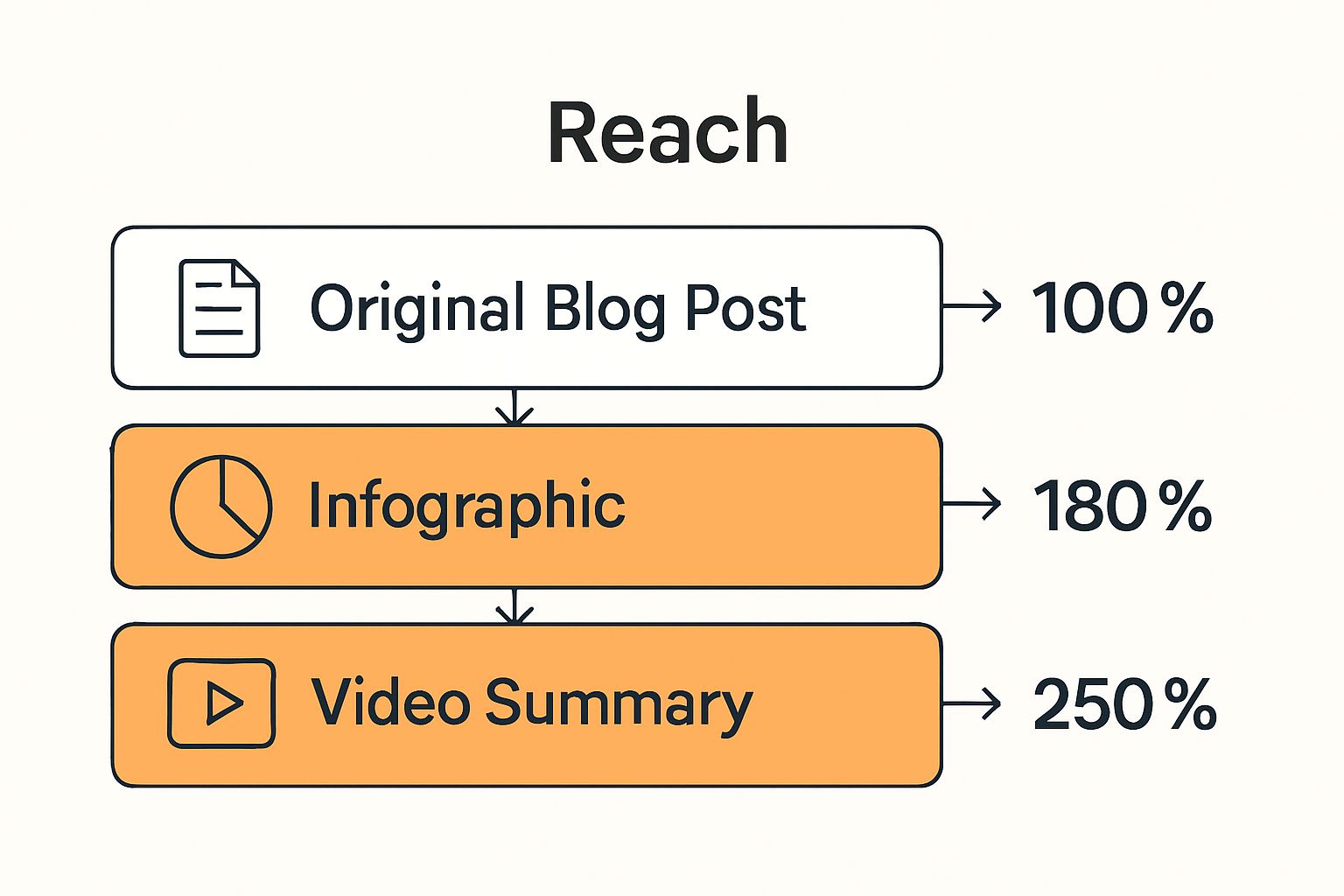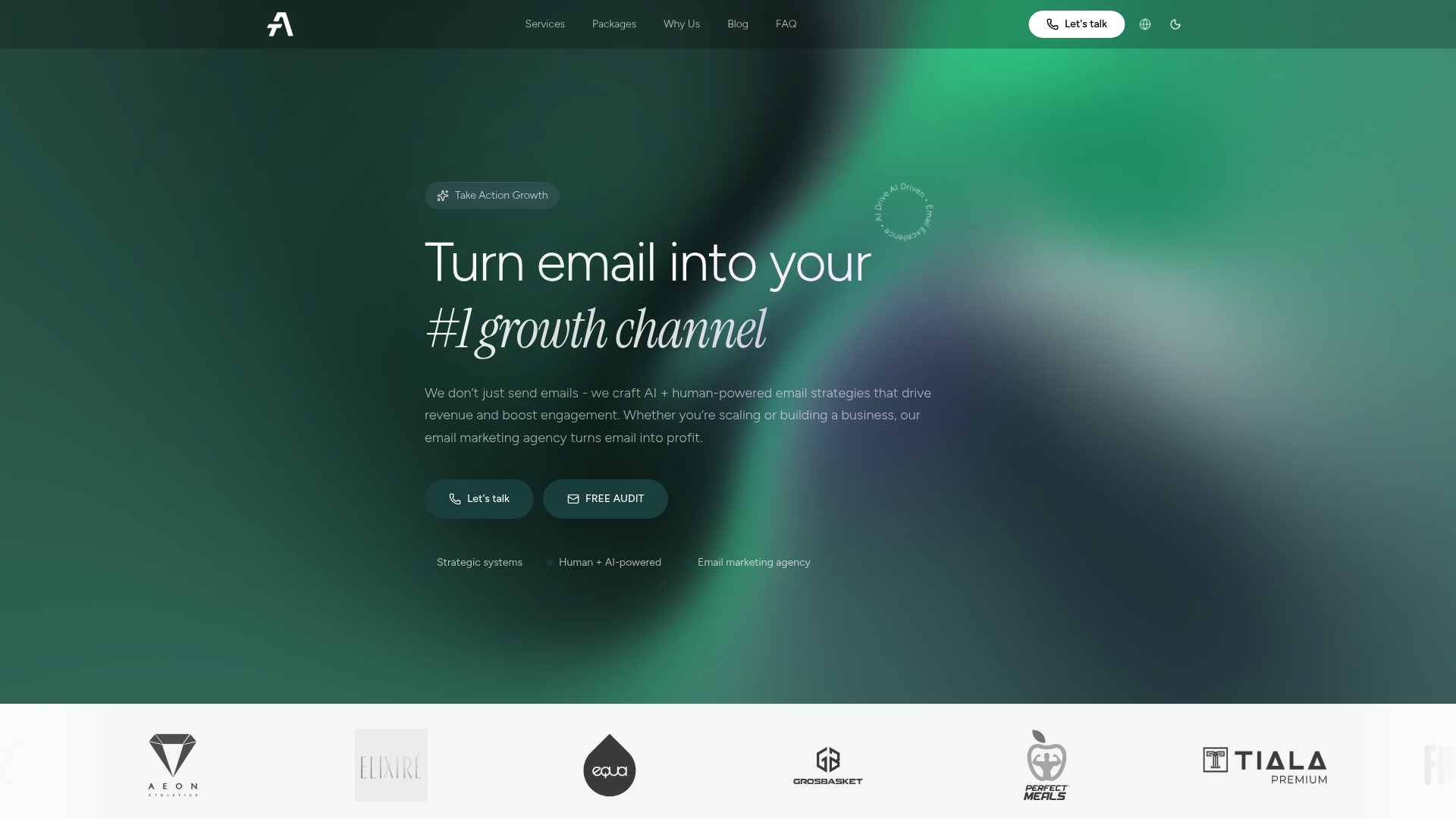What is Content Repurposing? Understanding Its Value
Everyone talks about how important it is to create fresh content online. But only a few realize that brands using content repurposing reach up to 3 times more audience segments than those who don’t. And the real surprise is this strategy does not mean doing more work. It’s about working smarter by turning one strong idea into powerful assets for every corner of the internet.
Table of Contents
- Defining Content Repurposing: What It Is
- The Importance Of Content Repurposing For Brands
- How Content Repurposing Improves Brand Engagement
- Key Concepts And Strategies In Content Repurposing
Quick Summary
| Takeaway | Explanation |
|---|---|
| Repurpose content to maximize ROI | Transform existing content into various formats to enhance its lifecycle and reach more audiences. |
| Enhance visibility through diverse formats | Different formats attract different audience segments, allowing greater message amplification without significant extra cost. |
| Cater to varied audience preferences | Deliver content in diverse styles to match how different demographics prefer to consume information. |
| Create consistent brand messaging | Repeated exposure across multiple formats reinforces brand recognition and builds trust with the audience. |
| Identify strong candidates for repurposing | Focus on high-performing content that has evergreen value and good engagement metrics for repurposing efforts. |
Defining Content Repurposing: What It Is
Content repurposing represents a strategic approach to content marketing that maximizes the value and reach of existing materials by transforming them into different formats. Content Marketing Institute defines this process as adapting and reusing original content across multiple platforms and mediums to extend its lifecycle and impact.
Understanding the Core Concept
At its essence, content repurposing is about reimagining your existing content through creative transformation. Instead of creating entirely new content from scratch, brands can take proven, successful materials and repackage them to reach different audience segments. This approach allows businesses to extract maximum value from their original content investment while simultaneously expanding their potential audience reach.
Below is a table summarizing examples of how a single piece of comprehensive content can be repurposed into various formats to maximize its value and reach different audience segments.
| Original Content Format | Repurposed Format | Audience Reach Benefit |
|---|---|---|
| Blog Post on Email Marketing Strategies | Infographic | Visual learners, social sharers |
| Blog Post on Email Marketing Strategies | Video Tutorial | Video audience, YouTube/search traffic |
| Blog Post on Email Marketing Strategies | Social Media Posts | Quick-consumption, daily users |
| Blog Post on Email Marketing Strategies | Podcast Episode | Audio learners, on-the-go listeners |
For instance, a comprehensive blog post about email marketing strategies could be repurposed into:
- A visually engaging infographic highlighting key statistics
- A short video tutorial explaining core concepts
- A series of social media posts breaking down individual insights
- A podcast episode discussing the deeper implications
Strategic Benefits of Content Repurposing
Beyond efficiency, content repurposing offers significant strategic advantages. Social Media Examiner reveals that brands utilizing strategic repurposing can dramatically increase their content’s visibility without exponentially increasing production costs. By adapting content to different formats, businesses can:
- Reach audiences with different content consumption preferences
- Reinforce key messages across multiple channels
- Improve search engine optimization through diverse content types
- Extend the useful life of high-performing original content
Understanding content repurposing means recognizing that great content is not a single-use asset, but a flexible resource waiting to be transformed and redeployed across your marketing ecosystem.
The Importance of Content Repurposing for Brands
Marketing research reveals that content repurposing is not just a tactical approach, but a strategic necessity for modern brands seeking to maximize their digital marketing investments. By transforming existing content into multiple formats, businesses can significantly amplify their message reach and engagement potential.
Cost Efficiency and Resource Optimization
Content creation demands substantial time, effort, and financial resources. Repurposing content provides an intelligent solution to reduce production costs while maintaining high-quality output. Instead of generating entirely new content for every marketing channel, brands can strategically adapt existing materials to suit different platforms and audience preferences.
For example, a single comprehensive research report can be transformed into:
- Bite-sized social media graphics
- An executive summary whitepaper
- A webinar presentation
- Podcast discussion points
- Targeted email campaign content
Expanding Audience Reach and Engagement
Demand Metric indicates that brands implementing content repurposing strategies can reach up to 3x more audience segments compared to traditional single-format content approaches. Different audience segments consume content through varied channels and formats.
 A professional might prefer a detailed white paper, while a younger demographic might engage more with a short video or infographic.
A professional might prefer a detailed white paper, while a younger demographic might engage more with a short video or infographic.
By diversifying content presentation, brands can:
- Capture attention across multiple platforms
- Reinforce key messaging through repetition
- Improve overall content discoverability
- Cater to diverse learning and consumption preferences
Content repurposing represents a sophisticated approach to digital marketing that transforms single content pieces into versatile, multi-platform assets. It enables brands to work smarter, not harder, in their content creation and distribution strategies.

How Content Repurposing Improves Brand Engagement
Digital Marketing Institute reveals that content repurposing is a powerful mechanism for enhancing brand engagement by creating multiple touchpoints with audiences through diverse content formats. By strategically transforming original content, brands can build deeper connections and maintain consistent messaging across various platforms.
Creating Consistent Audience Interactions
Content repurposing enables brands to maintain a continuous narrative across different channels. When audiences encounter your brand message through multiple formats, it reinforces brand recognition and builds trust. This multi-format approach allows businesses to create a cohesive brand experience that resonates with different segments of their target market.
For instance, a single comprehensive marketing research report can be reimagined into:
- Interactive social media infographics
- Thought leadership LinkedIn articles
- Short explainer YouTube videos
- Podcast interview segments
- Email newsletter highlights
Enhancing Audience Connection and Retention
Content Marketing Institute suggests that varied content formats significantly improve audience engagement and retention rates. Different audience segments consume information differently. Some prefer visual content, while others enjoy in-depth written analysis. By repurposing content, brands can:
- Cater to diverse learning and consumption preferences
- Increase overall content accessibility
- Provide deeper context through multiple perspectives
- Extend the lifecycle of high-performing content
Content repurposing transforms traditional marketing approaches by treating content as a dynamic, adaptable resource that can continuously evolve to meet audience needs and preferences.
Key Concepts and Strategies in Content Repurposing
Content Marketing Institute reveals that successful content repurposing requires a strategic approach that goes beyond simple format transformation. It demands a nuanced understanding of content potential and audience engagement dynamics.
Identifying Repurposing Opportunities
Not all content is equally suitable for repurposing. Brands must carefully evaluate existing content based on specific criteria to determine its potential for transformation. High-performing content with evergreen insights, comprehensive research, or complex explanations typically offers the most fertile ground for repurposing.
The table below compares different key indicators that signal strong content repurposing potential, aiding in deciding which materials should be prioritized for transformation.
| Indicator | Description |
|---|---|
| High Engagement Metrics | Consistently strong interactions (shares, likes, comments) |
| Comprehensive and Detailed Content | In-depth, long-form resources with robust coverage |
| Timeless (Evergreen) Insights | Information remains relevant over time |
| Tackles Complex or Multi-angle Topics | Covers subjects from several perspectives |
| Includes Rich Data or Statistical Insights | Contains original research or valuable statistics |
Key indicators of strong repurposing potential include:
- Consistently high engagement metrics
- Comprehensive and detailed original content
- Timeless information with ongoing relevance
- Content that addresses complex topics from multiple angles
- Materials with rich data or statistical insights
Strategic Content Transformation Techniques
HubSpot suggests multiple sophisticated strategies for transforming content across different platforms. The goal is not merely to copy content but to reimagine it through unique lenses that add value for specific audience segments.
Effective repurposing techniques encompass:
- Converting long-form blog posts into concise infographics
- Transforming webinar recordings into podcast episodes
- Breaking down comprehensive reports into social media carousel posts
- Creating video summaries of in-depth written content
- Developing interactive quizzes from research-backed articles
Content repurposing is an art of strategic adaptation, requiring creativity, analytical thinking, and a deep understanding of audience preferences across various digital platforms.
Unlock the True Power of Your Content with Strategic Email Repurposing
Are you pouring time and resources into content creation but frustrated by limited reach and engagement? The article explained how content repurposing can multiply your impact by breathing new life into your best work. Imagine if your top-performing blog post, infographic, or video could become a powerful source of ongoing customer engagement and revenue. That opportunity is waiting, especially when you combine expert email marketing strategy with smart content transformation.

Stop letting valuable content gather dust. At Take Action, we help ecommerce brands and online businesses turn existing assets into automated, conversion-focused email flows that nurture, convert, and retain customers. Let us show you how to leverage content repurposing using tools like Klaviyo to recover abandoned carts, boost open rates, and create personalized journeys that keep your audience coming back. Explore how our email marketing services can convert your strongest assets into scalable growth. Book a strategy call today and start seeing the results of smart, data-driven repurposing in your email campaigns—your next big win is just a click away.
Frequently Asked Questions
What is content repurposing?
Content repurposing is a strategic approach to content marketing that involves transforming existing content into various formats in order to maximize its value and reach across different platforms.
Why is content repurposing important for brands?
Content repurposing allows brands to extend the life of their content, reach diverse audience segments, and improve engagement while optimizing time and resources spent on content creation.
What are some effective strategies for repurposing content?
Effective strategies for repurposing content include converting blog posts into infographics, transforming webinars into podcast episodes, and breaking down reports into social media posts that highlight key insights.
How can content repurposing enhance audience engagement?
Content repurposing can enhance audience engagement by providing information in various formats that cater to different learning preferences, reinforcing brand messaging, and maintaining a continuous narrative across multiple channels.
Recommended
- What is a Content Hub? Understanding its Importance | Take Action Blog | Take Action
- Understanding the Value of Branded Content in Marketing | Take Action Blog | Take Action
- Understanding What Makes Content Shareable | Take Action Blog | Take Action
- 7 Evergreen Content Ideas for Growing Your Brand | Take Action Blog | Take Action
- How to Repurpose Content for Maximum Reach and Impact
- 7 Content Curation Strategies Every Business Owner Needs – My Blog
